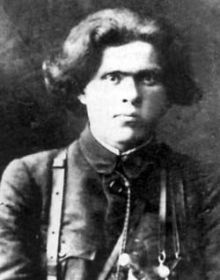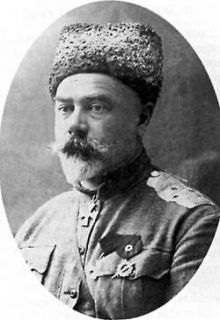At the time, Symon Petliura, chief otaman of the army of the Ukrainian National Republic (UNR), had a friendly view of the White Army. He ordered his troops to refrain from resisting General Denikin’s units and sent his envoys to the Whites’ headquarters with a proposal to conclude a joint anti-Bolshevik pact and divide the spheres of influence. Petliura regarded the latter point in a traditional way: the armies of the UNR and Denikin’s troops should control Right- Bank Ukraine and Left-Bank Ukraine, respectively. In taking this step, the Ukrainian commander-in-chief was also counting on the Entente’s support. But Denikin rejected Petliura’s initiative, declaring that he would never recognize the “traitor” and “bandit” Petliura and suggested that his army should either join Southern Russia’s armed forces or lay down its arms. Needless to say, the former tsarist general’s view was totally unacceptable to the staunch champions of an independent Ukraine.
In late August 1919 the Bolshevik government in Kyiv was overthrown. Ironically, this was done almost simultaneously by two forces — the Petliurites and the Denikinites — which seized the capital of Ukraine within a few hours. But Petliura failed again to establish “cordial” relations with the Whites. Moreover, it was this friendly attitude that enabled Denikin’s troops to expel Petliura’s units from Kyiv shortly afterwards, although the latter were at least five times numerically stronger than the “gold epaulettes,” and if they had wished they could have forced Denikin’s soldiers to abandon the city.
By late September 1919, the armies of Petliura and Denikin were again in a state of war. The desperate situation in which UNR units found themselves forced the chief otaman to abandon his old plan of reconciling with Denikin and to forge a temporary alliance in October 1919 with the Bolsheviks. Under this agreement, the Petliurites and the Bolsheviks were to fight jointly against the common enemy, the White Army, and, according to some sources, the Petliura command “ceded” some of its large units to the Reds.
True, the attitude of the White movement’s leadership to the UNR and its army was not always marked by unwillingness to compromise. In early 1920 the crushing defeats of the Volunteer Army at the hands of the Bolsheviks and Nestor Makhno forced the Denikin command to extend the hand of friendship to the Petliurites. On Jan. 7, 1920, the commander of the Volunteer Army’s Olviopil detachment, Colonel Popov, wrote to the otamans Omelianovych- Pavlenko and Tiutiunnyk, calling upon them to forget the old feud and launch a joint struggle against Bolshevism. In his letter, the Denikinite commander quite logically noted that Petliura’s army enjoyed the support of the Ukrainian population but did not have enough weapons, while Denikin’s army had more than enough weapons but the Ukrainians were taking a hostile attitude to it. Thus, an alliance would be advantageous to both sides. The White officer soon received a reply from the Ukrainian commanders: Petliura’s fighters were not in principle against such an alliance, but this could only be possible under two conditions: first, the Denikin command must unconditionally recognize Ukraine’s independence and, second, White Army units should merge with Petliura’s army and be fully subordinated to it. Naturally, Denikin’s headquarters could not accept these conditions.
In the second half of 1920 certain favorable conditions emerged for the formation of a military alliance between the UNR army and the Russian Army of Lieutenant-General Piotr “the Black Baron” Wrangel. On the one hand, both the Petliurites and the Wrangelites were being pursued by a common enemy — Bolshevik regiments — and, on the other, Wrangel’s attitude to the so-called Ukrainian question was much more liberal than that of his predecessor Anton Denikin. This may be explained by the fact that ethnic Ukrainians accounted for at least 60 percent of Wrangel’s army.
There is evidence that Petliura’s emissaries repeatedly visited Wrangel’s headquarters throughout 1920. Representatives of the UNR army’s chief otaman repeatedly emphasized that Ukrainian soldiers were prepared to fight with the Whites against the Bolsheviks, but this time, too, they insisted on the same mandatory condition: the “Black Baron” should unconditionally recognize Ukraine’s independence.
Facts indicate that the Russian Army’s commander in chief promised to restore the Zaporozhian Sich on the territory controlled by his troops in the event of a joint victory over the communists. On Nov. 8, 1920, Wrangel did what the White Army generals before him had never dared to: he recognized Ukraine’s independence. However, in spite of this, the expected military and political alliance between the Petliurites and the Wrangelites never came about. One week later the Red Army and Makhno’s troops took the Crimea by storm, and most of the Russian Army’s soldiers and officers were evacuated abroad and thus ceased to play any role in Ukrainian affairs.
At the same time, certain facts prove that in a number of cases the Ukrainian national army did forge an alliance with the White Army. For example, in November 1919 the Galician Army, whose commanders, unlike Petliura, regarded Denikin as simply an ally, formed a military alliance with him. Later, Petliura managed to conclude a military alliance with General Peremykin’s White Army, whose soldiers frequently fought shoulder to shoulder against the Reds.
However, for various reasons these anti-Bolshevik alliances were not viable at all. A large number of Galician soldiers were suffering from the terrible disease of typhus, which made them incapable of performing their military duties, while General Peremykin had too few soldiers to be able to reverse the course of events on the battlefield.
THE MONARCHISTS ALLIANCE WITH THE ANARCHISTS: GREAT HOPES AND POOR RESULTS
One of the strongest military-political movements in Ukraine during the Civil War was the so-called Makhnovshchyna (Makhno movement). This thousands-strong insurgent movement led by the anarchist leader Nestor Makhno was looked upon by other political forces as an attractive ally. The Russian Whites were no exception. They first hit upon the idea of forming an anti-Bolshevik alliance with Makhno in the spring of 1918, when batko (“father”) Makhno was a Red Army brigade commander. The White leaders were well aware of the serious political differences between Makhno and the communists, which they believed could help implement this idea.
On May 9, 1919, the White general Ataman Andrii Shkuro, ordered his chief of staff to write a letter to Makhno proposing a military alliance, since both the White Cossacks and the Makhnovists were equally hostile to the communist government, Red commissars, the Cheka (Soviet secret police), etc. But the White commander’s hopes were not realized because major differences between the Makhnovists and the Bolsheviks did not necessarily mean that Makhno, a sworn enemy of the “gold-epaulettes,” would immediately take the latter’s side. After reading the letter, Makhno announced publicly that he would never have anything to do with “bourgeois generals.” During the second half of 1919, in spite of their rift with the Red Army, the Makhnovists continued fighting the Whites as fiercely as before.
This story was repeated later, in 1920. Wrangel was pinning great hopes on the creation of a White Army-Makhno alliance. Unlike his predecessor Denikin, Wrangel favored establishing a military coalition of various anti-Bolshevik forces. In the spring and summer of 1920 the “Black Baron’s” headquarters sent three envoys to Makhno with a proposal to form an alliance between their two forces. But their mission failed: the first emissary, Lieutenant Yermakov, was arrested by the Soviet secret police before he reached Makhno’s headquarters, and the other two (a very young Captain Mikhailov and a middle-aged colonel) were publicly executed by the rebels. Affixed to the hanged body of Mikhailov was a board reading that Makhno had never entered into an alliance with the “White butchers,” and never will.
Nevertheless, the “Black Baron’s” efforts to win over Makhno’s insurgents were partially successful. A number of Makhno’s units led by the atamans Volodin, Savchenko, Yatsenko, Holyk, Ishchenko, Protchan, and others, joined Wrangel’s army in the spring and summer of 1920.
Approximately 3,000 Makhno fighters came over to Wrangel. Some of their commanders made special addresses to the populace, in which they stressed the necessity of joining forces with the Russian Army to fight the “Red commissars.” Wrangel allowed the White Makhno units to preserve their inner structure intact, as well as their old names (most of them were called “Batko Makhno regiments”).
Some historians claim that this was a fake alliance on the Makhnovists’ part: what lay behind it was Makhno’s wish to form a “fifth column” in Wrangel’s army, which would be able to deal a powerful blow to the enemy at the designated time. Some facts apparently confirm this theory, but I think this is only part of the truth. It is also quite likely that the “Makhno traitors” began to regard Wrangel not as an enemy but an ally, with good reason. First of all, the “Black Baron”, in contrast to “Tsar Anton” (as Denikin was often called by his comrades-in-arms), issued a slogan that was clearly borrowed from the Socialist Revolutionaries and which was very popular among the peasantry: “Land for the peasants!” Second, Wrangel’s propagandists were spreading the rumor that Wrangel and Makhno had already officially formed a military alliance. To prove this, they would often publicly display “combat orders” allegedly issued by Makhno. These forgeries were of high quality and impressed the population of southern Ukraine the way the Whites needed. In addition, the Wrangel army’s propagandistic actions were bolstered by a number of articles in the Bolshevik press about the alleged alliance between Makhno and the White Army.
It is not easy to assess the contribution that the Makhnovist defectors made to the White’s cause, but, by all accounts, it was not significant. It is common knowledge that Wrangel’s army commanders utterly mistrusted Makhno’s former fighters and would hardly have assigned them important military tasks. There were serious grounds for their mistrust. The alliance of the “anarchists” and the “monarchists” proved to be fragile and short-lived. In September and October 1920 the Makhnovist units in Wrangel’s army received orders from Makhno’s headquarters to launch an armed struggle against the “Black Baron,” to whom most of them had sworn allegiance. A major role in this was played by Makhno’s great prestige as well as the awareness of the imminent defeat of Wrangel’s regime. The “prodigal sons” returned to Makhno’s army, thereby contributing to the toppling of Wrangel, while several atamans, staunch advocates of the alliance between the white and black flags, were shot on Makhno’s personal orders.
Volodymyr HORAK is a historian.








